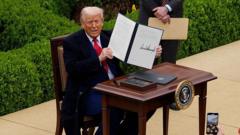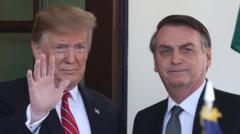In a striking move, President Trump revealed a 25% tariff on exports from South Korea and Japan, set to take effect on August 1. This tariff announcement also included the extension of a previously planned pause on steeper tariffs against various countries. In response, market indices experienced a noticeable decline as investors expressed alarm at the potential impact on trade with two of the U.S.'s major partners. Beyond South Korea and Japan, Trump disclosed a higher 40% tariff for Myanmar and Laos, 30% for South Africa, and additional 25% tariffs for Kazakhstan and Malaysia.
Trump's New Tariffs Target Key Allies in Asia

Trump's New Tariffs Target Key Allies in Asia
President Trump's recent announcement of a 25% tariff on exports from South Korea and Japan raises concerns over international trade relations.
The backdrop to these tariff threats is a complicated landscape of ongoing trade negotiations that have largely stalled over the past 90 days. As the administration endeavors to finalize agreements with multiple nations, it has only managed to secure preliminary deals with the UK and Vietnam thus far. The sluggish pace of negotiations with Japan and South Korea may stem from both countries experiencing recent elections and their hesitance to agree to any terms while facing the looming threat of additional tariffs on their key exports such as cars, steel, and electronics.
In a bid for transparency, Trump shared letters on social media where he specified these impending tariffs, providing a detailed account of the U.S.'s evolving trade stance in the Asia-Pacific region. The economic milieu surrounding these tariffs reflects an ongoing tension as partners weigh the ramifications of escalating trade barriers against the purported need to protect American industries. As the situation develops, stakeholders will keenly observe how this impacts global market dynamics and diplomatic ties in this critical sector.
In a bid for transparency, Trump shared letters on social media where he specified these impending tariffs, providing a detailed account of the U.S.'s evolving trade stance in the Asia-Pacific region. The economic milieu surrounding these tariffs reflects an ongoing tension as partners weigh the ramifications of escalating trade barriers against the purported need to protect American industries. As the situation develops, stakeholders will keenly observe how this impacts global market dynamics and diplomatic ties in this critical sector.


















